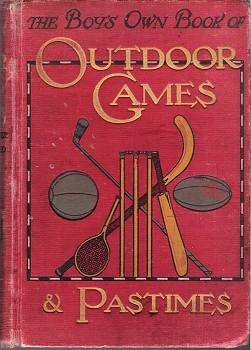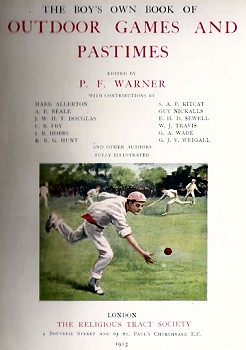 |
surfresearch.com.au
abbott : surfing in australia, 1913 |
| home | catalogue | history | references | appendix |
|
From the context,
the author appears to be an English visitor to Australia- in particular
note the reference to the lack of bathing machines in the final paragraph.
It is possible that
Abbott's observations were augmented by a number of previously published
articles promoting the Australian beach-side.
For example, see:
1908 C.D.P. :
Sun-Baking,
Surf-Bathing, and Camp Life in NSW.
The Red Funnel,
Dunedin, New Zealand.Volume VI, Number 3, April 1908, pages 268 to 271.
and
1910 Egbert T.
Russell : Australia's Amphibians.
The Lone Hand,
January 1, 1910.
Some of Abbott's
observations are questionable.
It is unlikely that
the surf-boat was "flat-bottomed" (page 179) and the following comment
is probably an exaggeration:
"In the summer
there are as many people in the water in the night-time as in the day."
-
page 180.
Note that night
swimming is not reported by other contemporary commentators.
It is possible that
H.S. Abbott either accompanied or consulted William Henry, the Chief Secretary
and founder of the Royal Life Saving Society in England in the 1890s, who
toured Australia and New Zealand at the end of 1910.
The connection is
admittedly slight- Abbott's chapter is immeditely followed in the book
by an article by Henry, Practical Lessons in Life Saving, pages
181 to 18?
Wm. Henry Esq. was
the official guest at a surf carnival at Manly Beach in late 1910, see:
1910 New South
Wales Surf Bathing Association.:
Combined
Surf Carnival Souvenir Programme
North Steyne,
Manly, 22nd October 1910.
SWIMMING.
Probably the most
delightful and invigorating pastime in Australia is surfing, that is sea-bathing.
In a very hot
climate such as that of Australia, this kind or sport is well patronised
by both sexes and all classes.
No wonder the
Australian lad is such a splendid swimmer; and Australia should be proud
of such men as Cecil Healey, Beaupaire, and Hardwick, of whom most English
boys will have heard.
There is a little town about nine miles from Sydney in New South Wales which is a great resort for surf bathers, and every morning one can find hundreds of bathers enjoying their "morning surf." This Iittle place is called Manly; it owns a beautiful long wide beach or soft sand, and the waves break about two hundred yards from the water's edge.
Shooting the
Breakers.
One of the great
items of sport is "shooting the breakers," that is to swim out to where
the waves are breaking and turn with the wave when it breaks and let its
force carry you in.
This is a real
pleasure to those who are expert, and it is quite suprising at what rate
the waves will carry a person in.
But there is
an art in "shooting the breakers" and it is not every one who can catch
a wave at the right moment.
If the bather
is a moment too late in reaching the crest of the wave, he is what is called
"dumped," that is to say, he gets under the wave and is curled up like
piece of paper, and if the sea is running high he will receive a severe
knocking about.
On the other
hand, if the bather is a second too soon in getting on to the wave, he
will simply catch the swell and not get the force of the breaker, and be
left where he is.
There is nothing
more delightful in the water than to catch a good breaker at the right
moment and be able to navigate oneself right up to the water's edge.
Good breaker
shooters can reach right up to the sand, having at the finish only mere
ripple of water to carry themselves upon.
Every year the great Surf Carnival is held, and, if the weather be ...
Page 179
fine, there is
fun and sport galore.
The ball is generally
opened with a procession through the town in fancy dress and in bathing
costumes.
Other towns are
invited to join in the processions and the competitions, and, as there
is a Surf Club in every seaside resort around Sydney, the crowd is always
a goodly sized one.
Life Saving.
There is keen
competitions amoungst the various clubs as to the best breaker shooters
and life-saving teams.
The Rules and
Regulations of the Surfare arranged by the Surf Club, and each club has
its own life-saving team, composed as follows: belt-man, line-men and two
reel-hands.
When a person
is seen in difficulties in the water, one of the team swims out to his
assistance, and supports the victim until the belt-man, who is provided
with a life-belt to which is attached a light line on a reel, reaches them;
then belt-man then takes the victim and, by holding up one hand, gives
the signal for the reel-men to wind in the line, thus drawing them speedily
on to the shore.
The teams are
all instructed in First Aid to the Drowning, and, if the victim needs it,
he is treated with first aid.
Many lives every
year are saved by these teams, three or four cases a day not being unusual.
The Carnival
at Manly.
At Manly there
is always a greatday when the Carnival is on, crowds of people from miles
around coming to see the sports.
The programme
of sports commences with life-saving displays by the various clubs' teams,
the winning team being the one that rescues its man in the least time;
next, generally, follows shooting the breakers, the prize being awarded
to the person who takes the longest shoot and does it in the neatest style;
then follows swimming races of one hundred or two hundred yards - longer
distances would not be safe on account of the sharks that infest this coast.
Although there
has never been a bather taken by a shark in Manly, there have been some
taken a little farther up the coast, and sharks have ben seen at Manly.
When a shark is
spotted, every bather is ordered out of the water immediately, althoiugh
they do not generally require much ordering out, mostbeing only too pleased
to be on dry land again.
Bathers who swimm
out any great distance are nicknamed "shark-baits."
There is a later
display by the club's surfboat.
This is very
exciting.
The boat is flat-bottomed
and manned by half a dozen men.
It is rowed out
past the line of breakers, turned around facing the shore, and the rowers
then wait to catch a good wave and come right to shore.
This boat takes
some navigating, for very often a wave cathes her broadside on, and over
she goes.
Surf-bathing is carried on nearly all year round at Manly, ...
Page 180
... owing to the
mild climate in the winter, some swimmers not missing a single morning
all the year.
In the summer
there are as many people in the water in the night-time as in the day.
It is common
occurrence to see families on a fine moonlight night making their way down
to the beach to spend an hour or so in the sea.
Of the different
styles of swimming perhaps the "trudgeon" and "crawl" strokes are the most
popular; very seldom is the "breast" or "side" stroke used.
For speed certainly
the "crawl" is the best, and is used by the record breakers,
One thing very
noticeable about the "surfers" is how brown they are through the sun.
Most people after
coming out of the sea will have what is known as a "sunbake."
They will lie
in the sun with just their swimming costumes on for hours at a time, and
there are a lot of boys who, but for their fair hair, would be taken for
black men.
The Australian
boy is very proud of being sunburnt and browned, and will smear himself
with cocoa-nut oil before lying in the sun, as this oil makes the skin
brown and prevents the body from peeling.
It does not take
very many bakings with cocoa-nut oil to make the skin brown.
At the Surf carnivals
there is always a competition for sunburnt boys called the "Brown Man Competition,"
at which a prize is given to the boy who has the brownest skin.
There are no bathing machines in Australia as there are in England, permanent dressing sheds being generally provided by the town council, and every comfort in the shape of shower baths, etc., is provided for the public by the authorities.
 |
 |

| home | catalogue | history | references | appendix |